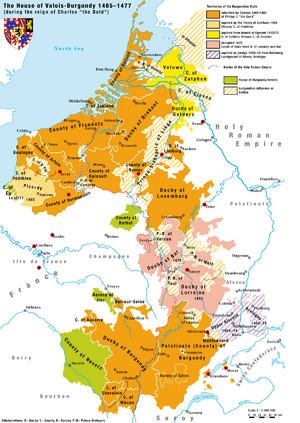Timeline of Burgundian and Habsburg acquisitions in the Low Countries facts for kids
Around the 1200s and early 1300s, many cities in the Netherlands region became very important. These cities played a big role in how their local areas were run and how money was made.
For example, cities in Flanders gained a lot of power over their county. When their leader, Louis II, Count of Flanders, passed away without a son, important cities like Bruges, Ypres, and Ghent made a plan. They arranged for his daughter to marry the Duke of Burgundy. This marriage started a series of events that led to the Burgundian rule. Later, in 1478, this region became known as the Habsburg Netherlands.
How Burgundy Grew Powerful
The Dukes of Burgundy slowly gained control over many different lands in the Netherlands region. This happened through smart marriages, buying new areas, and sometimes through battles.
- Starting in 1384: Philip the Bold became the ruler of Flanders, Artois, and the Free County. He got these lands by marrying Margaret III, Countess of Flanders. The powerful Flemish cities supported this marriage.
- Buying new lands in 1429: Philip the Good, who was Philip the Bold's grandson, bought the County of Namur from John III, Marquis of Namur.
- Inheriting more lands in 1430: When Philip of Brabant died without children, his nephew Philip the Good inherited his lands. This included Brabant, Lothier, and Limburg.
- Becoming Count in 1432: The Hook and Cod wars ended with the cities of Holland winning. They offered Philip the Good the chance to become the count of Holland, Zeeland, and Hainaut.
- Conquering Luxembourg in 1443: Philip also took control of the Duchy of Luxembourg.
- Influencing Church Leaders in 1456: Philip made sure his son, David, became the Bishop of Utrecht. This led to local fights known as the First and Second Utrecht Civil War.
- More Church Influence in 1456: He also helped his nephew Louis of Bourbon become the Prince-Bishop of Liège. This also caused conflicts, known as the Liège Wars.
- Guelders changes hands in 1473: Philip's son, Charles the Bold, bought the Duchy of Guelders from Duke Arnold. However, the House of Burgundy lost control of Guelders when Charles died in 1477.
- Charles the Bold's death in 1477: Charles the Bold died fighting against an alliance led by the King of France. France then took over the Duchy of Burgundy. Charles's daughter was Mary of Burgundy.
The Rise of the Habsburgs
After the Burgundian rule, the lands in the Netherlands came under the control of the powerful Habsburg family.
- A new marriage in 1478: Mary of Burgundy married Maximilian I of Habsburg. This marriage marked the start of the Habsburg Netherlands period.
- Charles V takes over in 1506: Maximilian and Mary's grandson, Emperor Charles V, inherited the Dutch lands. He was also the Holy Roman Emperor and the King of Spain.
- Expanding the Empire: Charles V continued to expand his family's control over more lands in the region.
- Tournai in 1521: Charles V took Tournai and the Tournaisis, which had been under French influence.
- Friesland in 1524: During the Guelderian Wars, Charles conquered Friesland, renaming it the Lordship of Frisia.
- Utrecht and Overijssel in 1528: Also during the Guelderian Wars, Charles took control of the Bishopric of Utrecht and its lands in Overijssel. These became the Lordship of Utrecht and Lordship of Overijssel.
- Groningen and Drenthe in 1536: Charles conquered the Lordship of Groningen and the County of Drenthe during the Guelderian Wars.
- Guelders reclaimed in 1543: Finally, Charles reclaimed the Duchy of Guelders and the County of Zutphen during the Guelderian Wars.
- Creating the Seventeen Provinces in 1549: Charles V issued an important rule called the Pragmatic Sanction. This rule officially united all these different Dutch lands into one group, known as the Seventeen Provinces.
Both the Burgundian and Habsburg periods were very important for the Netherlands. During these times, many different local areas were brought together under one ruler. However, this period ended with big problems. The rise of Protestantism, along with the policies of the Habsburg Empire, led to the Dutch Revolt and a long war for independence.


